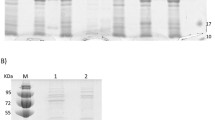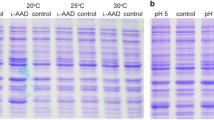Abstract
Aspartase (l-aspartate ammonia lyase, EC 4.3.1.1) catalyses the reversible amination and deamination of l-aspartic acid to fumaric acid which can be used to produce important biochemical. In this study, we have explored the characteristics of aspartase from Pseudomonas aeruginosa PAO1 (PA-AspA). To overproduce PA-AspA, the 1425-bp gene was introduced in Escherichia coli BL21 and purified. A 51.0-kDa protein was observed as a homogenous purified protein on SDS-PAGE. The enzyme was optimally active at pH 8.0 and 35 °C. PA-AspA has retained 56% activity after 7 days of incubation at 35 °C, which displays the hyperthermostablility characteristics of the enzyme. PA-AspA is activated in the presence of metal ions and Mg2+ is found to be most effective. Among the substrates tested for specificity of PA-AspA, l-phenylalanine (38.35 ± 2.68) showed the highest specific activity followed by l-aspartic acid (31.21 ± 3.31) and fumarate (5.42 ± 2.94). K m values for l-phenylalanine, l-aspartic acid and fumarate were 1.71 mM, 0.346 μM and 2 M, respectively. The catalytic efficiency (k cat/K m) for l-aspartic acid (14.18 s−1 mM−1) was higher than that for l-phenylalanine (4.65 s−1 mM−1). For bioconversion, from an initial concentration of 1000 mM of fumarate and 30 mM of l-phenylalanine, PA-AspA was found to convert 395.31 μM l-aspartic acid and 3.47 mM cinnamic acid, respectively.





Similar content being viewed by others
References
Werpy, T. and Petersen, G., Werpy, T., & Petersen, G. (2004). Top value added chemicals from biomass: volume I—results of screening for potential candidates from sugars and synthesis gas. Other Information: PBD: 1 Aug 2004, Medium: ED; Size: 76 pp. pages. doi:10.2172/15008859
Kisumi, M., Ashikaga, Y., & Chibata, I. (1960). Studies on the fermentative preparation of L-aspartic acid from fumaric acid. Bulletin of Agricultural Chemistry Japan, 24, 296–305.
Chao, Y. P., Lo, T. E., & Luo, N. S. (2000). Selective production of L-aspartic acid and L-phenylalanine by coupling reactions of aspartase and aminotransferase in Escherichia coli. Enzyme and Microbial Technology, 27(1–2), 19–25. doi:10.1016/S0141-0229(00)00149-6.
Papierz, M., Gadomska, G., Sobierajski, B., & Chmiel, A. (2007). Selection and activation of Escherichia coli strains for L-aspartic acid biosynthesis. Polish Journal of Microbiology, 56(2), 71–76.
Edreva, A. (2005). The importance of non-photosynthetic pigments and cinnamic acid derivatives in photoprotection. Agriculture, Ecosystems & Environment, 106, 135–146.
Hrazdina, G. (1992). Biosynthesis of flavonoids. Basic Life Science, 59, 61–72.
Shi, W., Dunbar, J., Jayasekera, M. M. K., Viola, R. E., & Farber, G. K. (1997). The structure of L-aspartate ammonia-lyase from Escherichia coli. Structure, 2960(97), 9136–9144.
De, P., Baltas, M., & Bedos-Belval, F. (2011). Cinnamic acid derivatives as anticancer agents—a review. Current Medicinal Chemistry, 18(11), 1672–1703. doi:10.2174/092986711795471347.
Ekmekcioglu, C., Feyertag, J., & Marktl, W. (1998). Cinnamic acid inhibits proliferation and modulates brush border membrane enzyme activities in Caco-2 cells. Cancer Letters, 128, 137–144.
Lesyk, R., Vladzimirska, O., Holota, S., Zaprutko, L., & Gzella, A. (2007). New 5-substituted thiazolo [3,2-b] [1,2,4]triazol-6-ones: synthesis and anticancer evaluation. European Journal of Medicinal Chemistry, 42, 641–648.
Ahmed, K., Gorre, B., Gadupudi, R., Kokkonda, S. Rajeinder (2014). Cinnamido pyrrolo[2,1-c][1,4]benzodiazepines as potential anticancer agents and process of the preparation thereof. US patent, US008722665B2.
Giles, F., Fischer, T., Cortes, J., Garcia-Manero, G., Beck, J., Ravandi, F., Masson, E., Rae, P., Laird, G., Sharma, S., Kantarjian, H., Dugan, M., Albitar, M., & Bhalla, K. (2006). A phase I study of intravenous LBH589, a novel cinnamic hydroxamic acid analogue histone deacetylase inhibitor, in patients with refractory hematologic malignancies. Clinical and Cancer Research, 12(15), 4628–4635.
Schobert, R., Kern, W., Milius, W., Ackermann, T., & Zoldakova, M. (2008). Synthesis of the first unnatural schisantherins and their effects in multidrug-resistant cancer cells. Tetrahedron Letters, 49, 3358–3362.
Sova, M. (2012). Antioxidant and antimicrobial activities of cinnamic acid derivatives. Mini Reviews in Medicinal Chemistry, 12(8), 749–767. doi:10.2174/138955712801264792.
Sharma, P. (2011). Cinnamic acid derivatives: a new chapter of various pharmacological activities. Journal of Chemical and Pharmaceutical Research, 3(2), 403–423.
Nishimura, S., Asai, A., Amishiro, N., Kobayashi, E., Gomi, K., & Saito, H. (1997). Synthesis and antitumor activity of duocarmycin derivatives: A-ring pyrrole compounds bearing cinnamoyl groups. Journal of Medicinal Chemistry, 40, 972–979.
Khatkar, A., Nanda, A., Kumar, P., & Narasimhan, B. (2014). Synthesis, antimicrobial evaluation and QSAR studies of p-coumaric acid derivatives. Arabian Journal of Chemistry. doi:10.1016/j.arabjc.2014.05.018.
Mizobata, T., & Kawata, Y. (2007). Aspartases: molecular structure, biochemical function and biotechnological applications, In Industrial enzymes: “structure, function and applications.” (A. P. Polaina, J., and MacCabe, Ed.). New York: Springer.
Kartsen, W. E., Hunsler, J. R., & Viola, R. E. (1985). Purification of aspartase and aspartokinase homoserine dehydrogenase I from Escherichia coli by dye-ligand chromatography. Analytical Biochemistry, 147(2), 336–341. doi:10.1016/0003-2697(85)90280-5.
Takagi, J. S., Ida, N., Tokushige, M., Sakamoto, H., & Shimura, Y. (1985). Cloning and nucleotide sequence of the aspartase gene of Escherichia coli W. Nucleic Acids Research, 13(6), 2063–2074. doi:10.1093/nar/13.6.2063.
Shintaro Suzuki, J., & Junko Yamaguchi, M. T. (1973). Studies on aspartase. I. Purification and molecular properties of aspartase from Escherichia coli. Biochimica et Biophysica Acta - Proteins and Proteomics, 321(1), 369–381.
Takagi, J. S., Fukunaga, R., Tokushige, M., & Katsuki, H. (1984). Purification, crystallization and molecular properties of aspartase from Pseudomonas fluorescens. Journal of Biochemistry, 96(066), 545.
Takagi, J. S., Tokushige, M., Shimura, Y., & Kanehisa, M. (1986). L-Aspartate ammonia-lyase and fumarate hydratase share extensive sequence homology. Biochemical and Biophysical Research Communications, 138(2), 568–572. doi:10.1016/S0006-291X(86)80534-4.
Sun, D., & Setlow, P. (1991). Cloning, nucleotide sequence, and expression of the Bacillus subtilis ans operon, which codes for L-asparaginase and L-aspartase. Journal of Bacteriology, 173(12), 3831–3845.
Nuiry, I. I., Hermes, J. D., Weiss, P. M., Chen, C. Y., & Cook, P. F. (1984). Kinetic mechanism and location of rate-determining steps for aspartase from Hafnia alvei. Biochemistry, 23(22), 5168–5175.
Yoon, M.-Y., Thayer-cook, K. A., Berdis, A. J., Karsten, W. E., Schnackerz, K. D., & Cook, P. F. (1995). Acid-base chemical mechanism of aspartase from Hafnia alvei.pdf. 1. Archives of Biochemistry and Biophysics, 320(1), 115–122.
Kawata, Y., Tamura, K., Yano, S., Mizobata, T., Nagai, J., Esaki, N., et al. (1999). Purification and characterization of thermostable aspartase from Bacillus sp. YM55-1. Archives of Biochemistry and Biophysics, 366(1), 40–46. doi:10.1006/abbi.1999.1186.
Chibata, I., Tosa, T., & Sato, T. (1974). Immobilized aspartase-containing microbial cells: preparation and enzymatic properties. Applied Microbiology, 27(5), 878–885.
Sato, T., Nishida, Y., Tosa, T., & Chibata, I. (1979). Immobilization of Escherichia coli cells containing aspartase activity with κ-carrageenan. Enzymic properties and application for L-aspartic acid production. Biochimica et Biophysica Acta, 570, 179–186. doi:10.1016/0005-2744(79)90212-2.
Nishimura, N., Taniguchi, T., & Komatsubara, S. (1989). Hyperproduction of aspartase by a catabolite repressio-resistant mutant of Escherichia coli B harboring multicopy AspA and par recombinant plasmids. Journal of Fermentation Technology, 67, 107–110.
Singh, R. S., & Yadav, M. (2012). Single-step purification and characterization of recombinant aspartase of Aeromonas media NFB-5. Applied Biochemistry and Biotechnology, 167(5), 991–1001. doi:10.1007/s12010-012-9589-8.
Tajima, T., Hamada, M., Nakashimada, Y., & Kato, J. (2015). Efficient aspartic acid production by a psychrophile-based simple biocatalyst. Journal of Industrial Microbiology and Biotechnology, 42(10), 1319–1324. doi:10.1007/s10295-015-1669-7.
Nijkamp, K., Westerhof, R. G. M., Ballerstedt, H., De Bont, J. A. M., & Wery, J. (2007). Optimization of the solvent-tolerant Pseudomonas putida S12 as host for the production of p-coumarate from glucose. Applied Microbiology and Biotechnology, 74(3), 617–624. doi:10.1007/s00253-006-0703-0.
Sambrook, J., & Russell, D. W. (2001). Molecular cloning: a laboratory manual (3rd ed.). Cold Spring Harbor, New York: Cold Spring Harbor Laboratory Press.
Bradford, M. M. (1976). A rapid and sensitive method for the quantitation of microgram quantities of protein utilizing the principle of protein-dye binding. Analytical Biochemistry, 72, 248–254. doi:10.1016/0003-2697(76)90527-3.
Emery, T. F. (1963). Aspartase-catalyzed synthesis of N-hydroxyaspartic acid. Biochemistry, 2(5), 1041–1045.
Lutz, S., Lichter, J., & Liu, L. (2007). Exploiting temperature-dependent substrate promiscuity for nucleoside analog activation by thymidine kinase from Thermotoga maritima. Journal of the American Chemical Society., 129(28), 8714–8715.
Patel, M. J., Patel, A. T., Akhani, R., Dedania, S., & Patel, D. H. (2016). Bioproduction of D-tagatose from D-galactose using phosphoglucose isomerase from Pseudomonas aeruginosa PAO1. Applied biochemistry and biotechnology., 179, 715–727.
Viola, B. R. E. (2000). L-Aspartase: new tricks from an old enzyme in Advances in enzymology and related areas of molecular biology, (Vol. 74).
Fujii, T., Sakai, H., Kawata, Y., & Hata, Y. (2003). Crystal structure of thermostable aspartase from Bacillus sp. YM55-1: structure-based exploration of functional sites in the aspartase family. Journal of Molecular Biology, 328(3), 635–654. doi:10.1016/S0022-2836(03)00310-3.
Fibriansah, G., Veetil, V. P., Poelarends, G. J., & Thunnissen, A. M. W. H. (2011). Structural basis for the catalytic mechanism of aspartate ammonia lyase. Biochemistry, 50(27), 6053–6062. doi:10.1021/bi200497y.
MacDonald, J. M., & D'Cunha, G. B. (2007). A modern view of phenylalanine ammonia lyase. Biochemistry and Cell Biology., 85, 273–282. doi:10.1139/O07-018.
Kazuoka, T., Masuda, Y., Oikawa, T., & Soda, K. (2003). Thermostable aspartase from a marine psychrophile, Cytophaga sp. KUC-1: molecular characterization and primary structure. Journal of Biochemistry, 133(1), 51–58. doi:10.1093/jb/mvg012.
Kawata, Y., Tamura, K., Kawamura, M., Ikei, K., Mizobata, T., Nagai, J., et al. (2000). Cloning and over-expression of thermostable Bacillus sp. YM55-1 aspartase and site-directed mutagenesis for probing a catalytic residue. European Journal of Biochemistry, 267(6), 1847–1857. doi:10.1046/j.1432-1327.2000.01190.x.
Leonova, T. V., Voroshilova, E. B., & Gusyatiner, M. M. (2012). A method for producing an l-amino acid using a bacterium of the family Enterobacteriaceae having attenuated expression of a phosphate transporter-encoding gene. International patent, WO2012011595, 26 Jan 2012.
Rudolph, F. B., & Fromm, H. J. (1971). The purification and properties of aspartase from Escherichia coli. Archives of Biochemistry and Biophysics, 147, 92–98.
Author information
Authors and Affiliations
Corresponding author
Rights and permissions
About this article
Cite this article
Patel, A.T., Akhani, R.C., Patel, M.J. et al. Bioproduction of l-Aspartic Acid and Cinnamic Acid by l-Aspartate Ammonia Lyase from Pseudomonas aeruginosa PAO1. Appl Biochem Biotechnol 182, 792–803 (2017). https://doi.org/10.1007/s12010-016-2362-7
Received:
Accepted:
Published:
Issue Date:
DOI: https://doi.org/10.1007/s12010-016-2362-7




